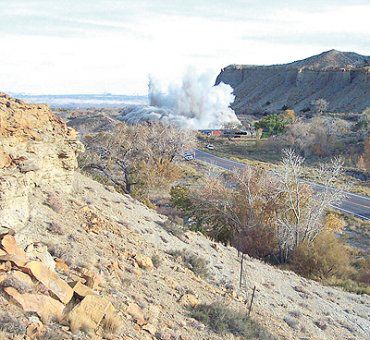The Cottonwood Creek Irrigation project continues to move forward and on Nov. 3, ground was cleared for the progression of the pipeline. At approximately 5:10 p.m., Terry R. Brotherson Excavating Company from Mt. Pleasant, used the 3-Rivers Drilling and Blasting Company from Cedar City, to blast a trench about a quarter mile long beside the Coal Haul Road which is west of Orangeville.
The blasting took place around the base of a bluff to loosen rock and shale so a backhoe could make a deep trench, big enough for the large pipe being used.
This is all part of the Cotton Wood Creek Irrigation Company pressurized irrigation project. As the pressurized irrigation pipe gets closer to the holding pond the pipe will get larger. The pipe will be as much as 60 inches or more in diameter. The holding pond or reservoir will be in the Adobe Wash across the highway from PacifiCorp’s Central Warehouse and South of XTO. The Adobe Wash Dam will be under construction this fall. Prior to setting off the explosive material, workers were observed laying two parallel lines about six or eight feet apart to holes drilled in the earth. These drilled holes were also about six or eight feet apart. The explosive material was placed in such a way, the blast caused the broken earth to rise up between the two parallel lines.
Before the blasting, the area was cleared of vehicles and people. When the blast took place a few spectators were on hand to see the event from a hill north of the blasting area.
The blasts began at the north end of the trench and rapidly moved south, raising a small amount of black smoke and a lot of dust from the earth being violently loosened. For 20 minutes or more the valley was filled with a large dust cloud.
When the dust cleared, the area where the blasting took place now held a three to four foot high ridge of rocks and broken shale about a quarter mile long. The broken rocks and loosened earth will now be easier for excavating equipment to remove.
A portion of the Coal Haul Road was covered with rocks and dirt, which had to be cleared before traffic could be resumed along the road. By 6 p.m. the road was cleared of debris for traffic.
The big blast broke the rock and reduced it to rubble.

"The big blast broke the rock and reduced it to rubble."
